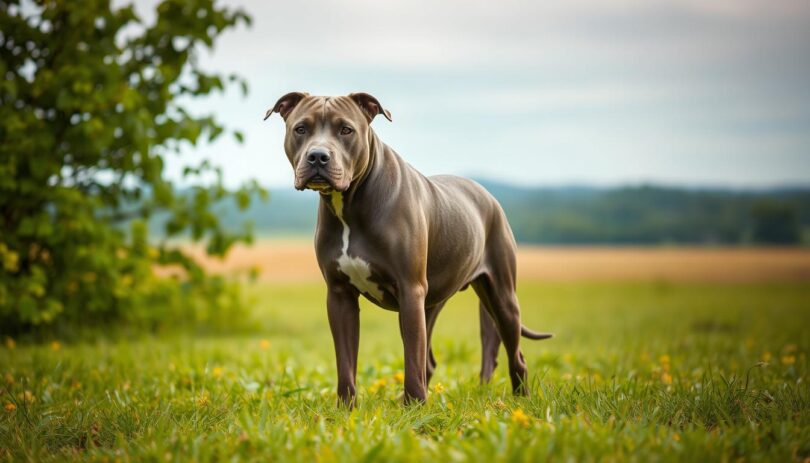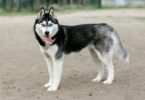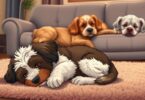Imagine meeting a dog with a sleek, silver-toned coat and eyes that radiate loyalty. Many pet lovers are captivated by this striking appearance, often linked to dogs called grey pitbulls. But what makes these companions unique? Let’s explore their story.
Contrary to popular belief, these dogs aren’t a separate breed. Their distinctive hue comes from a recessive gene that dilutes coat pigments. This genetic quirk creates shades ranging from soft charcoal to shimmering platinum. Despite their muscular build, well-socialized individuals often showcase surprising gentleness.
Owners frequently describe them as agile athletes with hearts of gold. Proper training and care unlock their potential as devoted family members. This guide will walk you through their physical traits, history, and essential care practices. You’ll also learn how to nurture their friendly nature while addressing common misconceptions.
Whether you’re considering adoption or simply curious, understanding these dogs’ true character matters. Their strength and spirit deserve recognition beyond stereotypes. Let’s discover what makes them extraordinary companions.
An Introduction to the Gray Pitbull Breed
Behind the shimmering coat of these loyal companions lies a rich history intertwined with 19th-century England. Originally bred from crosses between Old English Bulldogs and Terriers, these dogs inherited strength and tenacity. Their development aimed to create versatile working animals capable of herding livestock and guarding homes.
What Sets Gray Pitbulls Apart
The standout feature of these canines is their rare coat color. Unlike common brindle or fawn patterns, the silvery hue results from a recessive gene affecting pigment dilution. This genetic trait doesn’t alter their physical prowess but adds a unique visual appeal. Breed enthusiasts often seek this variety for its striking contrast against their muscular build.
An Overview of Breed Origins and Appeal
Early breeders prioritized traits like loyalty and adaptability, qualities that made them valuable to families. While often grouped with the American Pitbull Terrier or Staffordshire Bull Terrier, they’re recognized for their distinct roles. Historical records show they served as farm helpers before transitioning into household companions. Today, their intelligence and affectionate nature make them popular choices for active households.
Gray Pitbull Appearance and Unique Coloration Features
A rare genetic twist creates the mesmerizing coat colors seen in these muscular companions. Their distinctive hues range from steel-blue to misty silver, setting them apart from other canines. This coloring extends beyond fur, often influencing eye shades and nose pigmentation for a cohesive look.
Understanding the Blue-Grey Coat and Recessive Gene
The signature blue-grey coat stems from a recessive dilution gene affecting melanin production. Both parents must carry this gene for puppies to inherit the trait. This genetic quirk lightens black pigments to slate tones and brown shades to softer fawn. Some dogs develop striking amber eyes that complement their silvery fur.
Coat Variations: Brindle, Fawn, and Tricolor
Beyond solid hues, these dogs display diverse patterns. Brindle coats mix dark stripes with lighter bases, creating tiger-like markings. Fawn varieties showcase warm tan shades, while tricolor combinations blend three distinct hues. Similar patterns appear in American Pitbull Terriers, though the blue-grey tone remains unique to this lineage.
Proper care maintains coat health. Weekly brushing removes loose hairs and distributes natural oils. Owners should monitor skin conditions, as diluted pigments sometimes correlate with increased sensitivity. Regular vet checks help address any color-related health concerns early.
History and Genetic Background of the Gray Pitbull
These silver-coated canines trace their roots to 19th-century England, where breeders crossed Old English Bulldogs with agile Terriers. The goal? To create versatile working dogs capable of herding livestock and guarding properties. Over time, their roles shifted from farm duties to companionship as their loyal nature became apparent.
From Bull Baiting to Family Living Rooms
Early ancestors of modern breeds faced harsh tasks like bull-baiting. Thankfully, humane breeding practices redirected their traits toward family-friendly qualities. Old English Bulldog genetics contributed strength, while Terrier bloodlines added playfulness. Some lines later mixed with American Staffordshire Terriers, enhancing their adaptability to home environments.
How Genetics Shape Their Signature Look
The recessive dilution gene responsible for their coat requires both parents to carry it. This gene lightens base colors but may increase skin sensitivity in some dogs. Responsible breeders test for this trait to maintain healthy litters while preserving the unique hue.
Today’s pitbulls showcase how purposeful breeding transformed working dogs into affectionate pets. Understanding this history helps owners appreciate their companions’ resilience and intelligence.
Understanding the Temperament and Personality of Gray Pitbulls
Behind the muscular build of these loyal companions lies a heartwarming truth: their temperament thrives on affection and connection. Misconceptions about aggression often overshadow their natural desire to bond with their human families. When raised with care, they become steadfast protectors and playful partners.
Affectionate Nature and Family Loyalty
These dogs frequently surprise first-time owners with their gentle demeanor. Many form inseparable bonds with children, often showing patience during playtime. Stories abound of them curling beside toddlers or alerting families to visitors with soft woofs rather than intense barking.
Impact of Early Socialization on Behavior
Proper socialization shapes their personality more than genetics. Puppies exposed to diverse sounds, people, and animals between 3-14 weeks typically grow into confident adults. A well-socialized pitbull terrier might greet strangers with wagging tails or coexist peacefully with cats.
Training plays a crucial role in managing territorial instincts. Positive reinforcement methods work best, rewarding calm behavior around new stimuli. Pet parents who establish routines and clear boundaries often raise dogs that defy outdated stereotypes about aggression.
Creating a secure environment helps these sensitive animals flourish. Consistent affection, mental stimulation, and structured activities channel their energy productively. With the right approach, they transform into devoted family members who prioritize companionship over conflict.
Training and Socialization for a Happy Pitbull Life
Building a strong bond with these loyal dogs starts with understanding their learning style. Structured routines channel their natural energy into positive behaviors while strengthening trust. Consistent guidance helps them thrive as well-adjusted companions.
Effective Obedience Techniques and Positive Reinforcement
Reward-based methods work best for training. Use high-value treats or toys to mark desired actions immediately. Clicker training helps create clear communication during sessions.
Start with 10-minute daily drills focusing on commands like “sit” and “leave it.” Gradually increase difficulty as skills improve. Pitbulls also excel at agility exercises that combine physical challenges with mental stimulation.
Socializing With Other Dogs and Strangers
Begin socialization early using controlled exposures. Introduce new people at a distance first, rewarding calm behavior. For dog interactions, use parallel walks in neutral spaces before allowing direct play.
Make sure encounters stay positive. If your dog shows stress, create more space and try again later. Proper training transforms their strength into controlled responsiveness during meetings.
Busy families can integrate practice into routines. Teach “place” commands during dinner prep or practice leash skills on short walks. These micro-sessions reinforce good habits without overwhelming schedules.
Health Considerations and Common Problems in Gray Pitbulls
Maintaining optimal health in these athletic dogs requires understanding their unique biological needs. Their distinctive coat coloration, while striking, can correlate with specific vulnerabilities. Responsible owners should prioritize early detection and proactive management of potential conditions.
Identifying Genetic and Melanin-Related Issues
Three key concerns often affect these muscular companions. Hip dysplasia ranks high among genetic problems, potentially causing mobility challenges. Skin sensitivities linked to reduced melanin levels may lead to allergies or infections. Additionally, some dogs develop eye conditions like progressive retinal atrophy.
Diluted coat pigments sometimes indicate thinner skin barriers. Regular inspections for rashes or hotspots help catch issues early. Genetic testing during puppyhood provides insights into inherited risks, allowing tailored care plans.
Preventative Care and Regular Vet Checkups
Annual vet visits form the foundation of preventive health strategies. Professionals recommend:
- Joint supplements for dogs prone to dysplasia
- Hypoallergenic diets for sensitive skin
- Monthly parasite prevention routines
Families play a vital role through daily observation. Notice limping? Schedule an orthopedic exam. Spot excessive scratching? Request allergy testing. Early intervention often reduces treatment costs and discomfort.
Proper care extends beyond medical visits. Balanced nutrition and controlled exercise protect joint health. For those interested in similar genetic traits, research helps anticipate needs. Consistent grooming routines also minimize skin problems while strengthening the human-animal bond.
Exercise, Agility, and Activity Needs for Gray Pitbulls
High-energy canines with athletic builds thrive when given structured outlets. These muscular companions require purposeful physical challenges to maintain both body and mind. Tailoring activities to their natural abilities prevents boredom and promotes balanced behavior.
Importance of Regular Exercise and Play
Daily activity prevents destructive habits caused by pent-up energy. Most adult dogs need 60-90 minutes of exercise split into multiple sessions. Puppies and seniors benefit from shorter, more frequent playtimes adjusted for their stamina.
Strength varies across the breed. Smaller Staffordshire Bull Terrier mixes might enjoy brisk walks, while larger American Pitbull types need jogging or weight-pulling games. Always match intensity to your dog’s size and fitness level.
Engaging in Agility and Outdoor Activities
Agility training channels their athleticism through obstacle courses and timed challenges. Set up tunnels, jumps, or weave poles in your backyard. These exercises sharpen coordination while strengthening your bond.
Outdoor adventures like hiking provide mental stimulation. Alternate fetch sessions with scent-tracking games to engage their instincts. A tired dog isn’t just calmer – they’re more receptive to training and social interactions.
Remember: Mental workouts matter as much as physical ones. Puzzle toys during downtime keep their clever minds active. Consistent routines create happier, healthier companions ready for family life.
Caring for Your Gray Pitbull: Nutrition and Grooming
Daily care routines shape both physical vitality and emotional well-being in active canines. Tailoring strategies to their metabolism and coat type ensures these athletes stay healthy and shiny. Let’s break down essential practices for nourishment and maintenance.
Balanced Diet and Feeding Recommendations
High-energy breeds thrive on protein-rich meals with 25-30% animal-based content. Feed adults 2-3 cups daily, split into two meals. Puppies need smaller portions 3-4 times a day. Look for omega-3 fatty acids to support skin health beneath their glossy coats.
Monitor weight through rib checks – you should feel but not see them. Adjust portions if your dog becomes less active. Always provide fresh water, especially after exercise sessions.
Grooming Tips for Maintaining a Healthy Coat
Weekly brushing removes loose hairs and spreads natural oils. Use a rubber curry brush for short coats. Bathe monthly with oatmeal-based shampoo to prevent dryness. Wipe wrinkles around the face after meals to avoid irritation.
Inspect paws and nails regularly. Trim every 3-4 weeks to prevent cracking. Many owners find vet-recommended moisturizers helpful for sensitive skin areas.
Combine these habits with annual checkups. Pet parents who track dietary responses and coat changes often catch health issues early. Consistent care builds trust while keeping your companion looking and feeling their best.
How Gray Pitbulls Make Excellent Family Companions
Families seeking loyal four-legged members often discover these dogs thrive in active households. Their affectionate nature shines when raised with consistent routines and positive reinforcement. Properly socialized puppies grow into adults who prioritize their human pack above all else.
Compatibility With Children and Other Pets
Early socialization shapes how these dogs interact with kids. Many owners report their pets instinctively gentle around toddlers, often sitting calmly during play. Introductions to cats or smaller animals work best when supervised and reward-based.
Stories of the breed’s historical role as “nanny dogs” persist for good reason. Modern examples show them alerting families to open gates or keeping watch over napping babies. Structured interactions build trust between dogs and children, especially when adults model respectful handling.
Building a Safe and Loving Home Environment
Secure spaces prevent accidents while fostering confidence. Use baby gates to create designated zones for puppies and visiting pets. Store chewable items out of reach until training solidifies good habits.
Daily enrichment matters as much as physical safety. Rotate puzzle toys to challenge their problem-solving skills. Combine play sessions with obedience drills to strengthen bonds. Families find success pairing morning walks with evening cuddle routines.
Nutrition plays a role in household harmony. High-quality food reduces hyperactivity, while scheduled meals establish predictability. Always consult your vet when adjusting diets for growing puppies or senior dogs.
Comparing Gray Pitbulls with Other Pitbull Varieties
Understanding breed differences helps owners appreciate what makes each dog unique. While many share similar roots, subtle variations in appearance and temperament set them apart. Let’s explore key distinctions between popular types.
American Pitbull Terrier vs. Staffordshire Bull Terrier
The American Pitbull Terrier typically weighs 30-60 pounds with a leaner build, bred for agility. Staffordshire Bull Terriers often stay under 50 pounds, featuring broader heads and stockier frames. Both breeds show loyalty, but Staffies tend to adapt better to apartment living due to moderate energy levels.
Historical roles shaped these differences. American lines focused on farm work, while Staffords evolved as companion animals. Genetic testing reveals distinct lineage markers between the two, though both fall under the broader “pitbull” category.
Separating Fact From Fiction in Breed Reputation
Media sensationalism often skews public perception of these dogs. Studies by the American Temperament Test Society show 87% of tested pitbulls pass behavior assessments – higher than many popular breeds. Aggression stems more from environment than genetics, as proven by their historical role as family-oriented companions like brindle pit bulls.
Breed-specific legislation often overlooks key data. Responsible ownership and proper training create well-adjusted pets regardless of coat color or ancestry. By focusing on individual behavior rather than stereotypes, families discover loving partners in these misunderstood dogs.
Wrapping Up the Guide on Gray Pitbull Ownership
Owning a silver-coated companion brings unique joys and responsibilities. These dogs combine striking genetics with loyal temperaments, tracing their roots to Old English working breeds. Their signature coat stems from a recessive gene requiring careful breeding considerations.
Successful ownership hinges on proper training and early socialization. Consistent routines help channel their energy into positive behaviors. Regular vet visits address health needs linked to skin sensitivity and joint health.
Pet parents who invest time in bonding activities often discover devoted family members. While muscular in build, these animals thrive on affection and structured play. Their history as adaptable workers translates well to modern home life when given clear guidance.
This guide provides everything you need to know about care, genetics, and behavior. With attention to nutrition, exercise, and mental stimulation, these breeds flourish. Responsible ownership transforms stereotypes into stories of trust and companionship.
FAQ
Are gray coats in Pitbulls linked to health issues?
The recessive gene responsible for blue-gray coats can sometimes correlate with skin sensitivities or allergies. Regular vet visits help identify and manage these conditions early.
How do Staffordshire Bull Terriers differ from American Pitbull Terriers?
Staffordshire Bull Terriers are typically smaller and stockier, while American Pitbull Terriers have a leaner build. Both share loyalty and energy but vary in exercise needs and regional breed standards.
Can these dogs coexist peacefully with other pets?
With proper socialization from puppyhood, they often adapt well to multi-pet households. Supervised introductions and consistent training reinforce positive interactions.










Leave a Comment